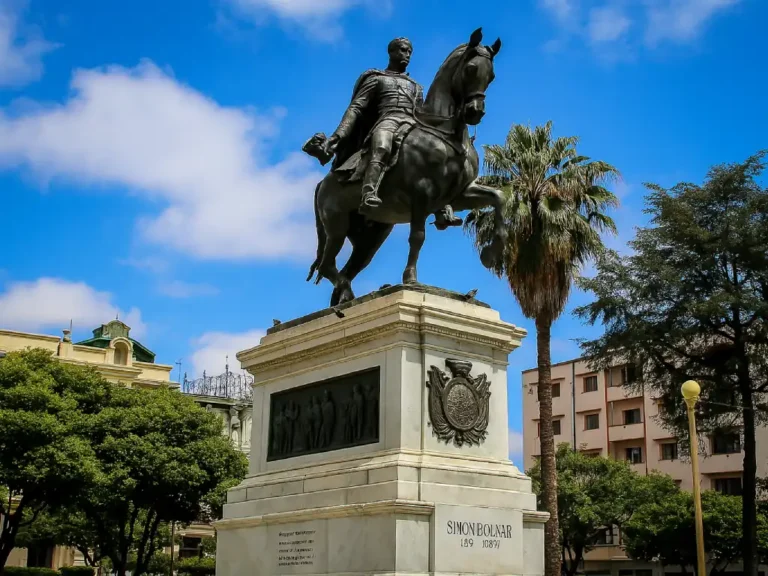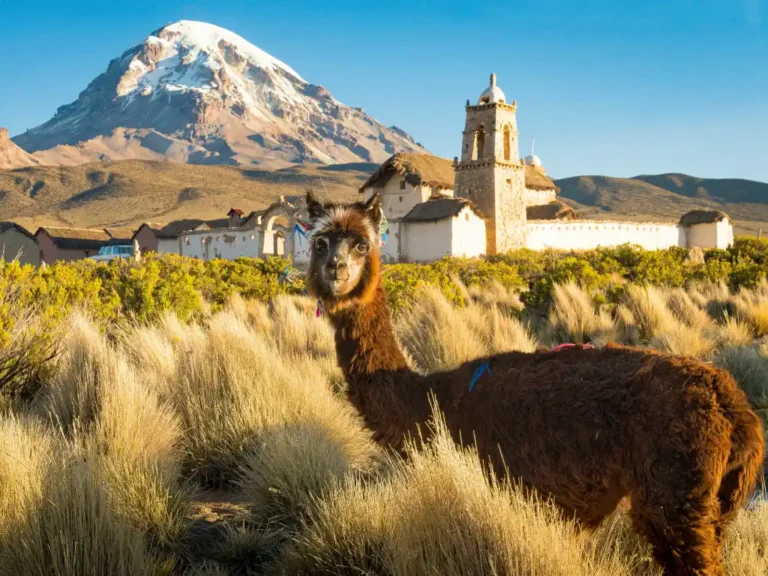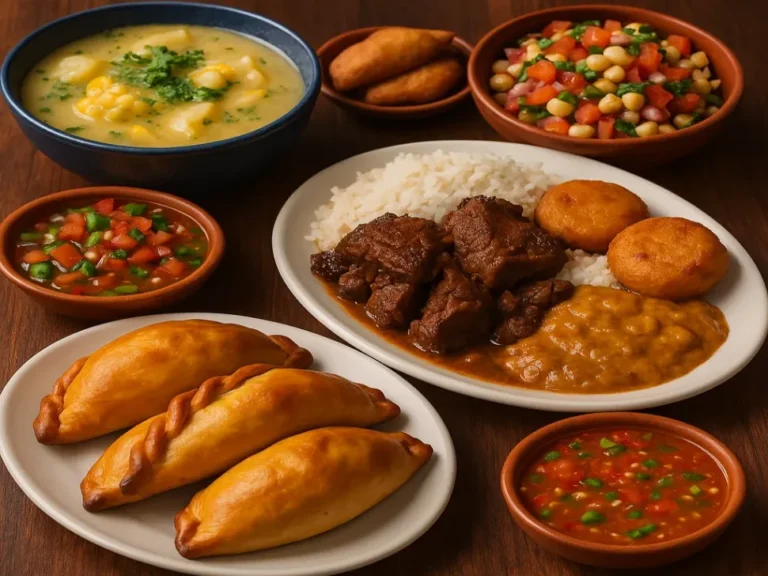Wiphala Flag Meaning: Bolivia’s Indigenous Rainbow Symbol Explained
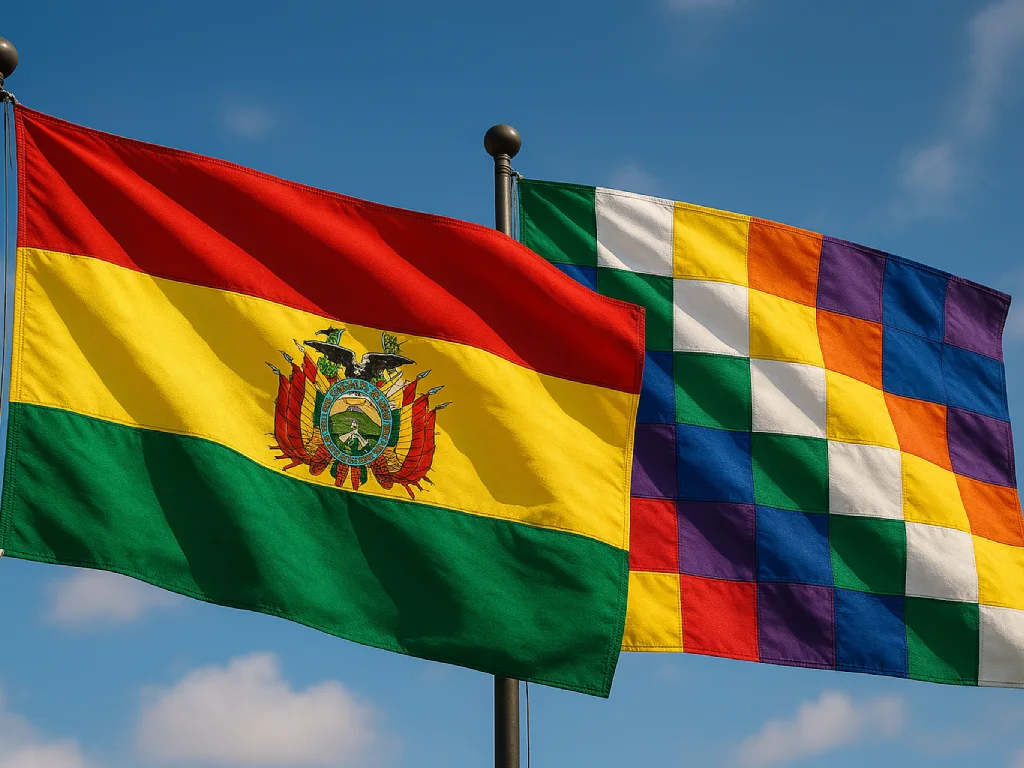
You’ve probably seen it – That rainbow flag flying beside Bolivia’s tricolour… yep the one that looks like Tetris on shrooms. It’s called the Wiphala, & it’s not just a splash of colour. Whether it’s called the Quechua flag, Aymara flag, or just Bolivia’s Indigenous flag… the Wiphala tells a much bigger story. So what does it actually mean?
Let’s break down what the Wiphala flag meaning – where it came from, who flies it, & why it matters.
Wiphala Flag Meaning .. first off, what is the Wiphala?
The Wiphala flag represents Indigenous unity, resistance & balance in Andean culture – especially among the Aymara & Quechua peoples. In my wanderings around Bolivia, I was seeing it everywhere – on government buildings, parades, protests & street corners – especially in western Bolivia.
It’s widely flown across the Andes – especially by Aymara & Quechua communities – as a living emblem of Andean resistance, pride & spiritual connection to place. Over the years its also become known as one of the many important things that represent Bolivia.
If you’re curious how this cultural pride ties into everyday life, you might enjoy reading about Bolivia’s holidays & traditions – loads of them include the Wiphala front & centre.
Origin & Cultural Symbolism
Long before the Wiphala hit government buildings, versions of it were showing up in ancient Andean textiles, ceramics & woven fabrics – especially among the Tiwanaku people.
The checkerboard design we know today might look modern, but it’s more of a remix than a brand-new jam.
Why does Bolivia have two flags?
Yep, Bolivia officially recognises two national flags – the red, yellow & green tricolour you probably know, & the Wiphala. The two were given equal status in the 2009 Constitution, as part of an effort to better represent the country’s Indigenous majority.
Fun fact: The Wiphala’s inclusion in the Constitution sparked protests in some areas where people felt it didn’t represent them – especially in Bolivia’s eastern lowlands, which lean more mestizo or European in culture.
It wasn’t without controversy (some people still refuse to accept it) but for Indigenous Bolivians, seeing the Wiphala flown at the same height as the national flag is powerful.
If you’ve also ever wondered what the symbol on the Bolivian flag means, it’s not just random artwork – every part tells a story. (Mountains, wheat, weapons – all in there.) More on that directly below!
If this kind of political quirkiness piques your interest, you might want to read about why Bolivia has two capitals – it’s just as tangled.
Why is the Wiphala controversial?
The Wiphala might look cheerful, but its presence in Bolivian politics is anything but mellow. When it was given national flag status in 2009, it kicked off protests in parts of the country – especially in eastern Bolivia, where some felt it didn’t represent their heritage. You’ll still find people who see it as politically charged or divisive. For many Indigenous Bolivians though, it’s a powerful statement of identity & equality – and seeing it flown alongside the tricolour means a lot.
2019 Political Crisis Removal
Tension boiled over during the 2019 political crisis – the flag was removed from official places under interim president Jeanine Áñez, only to be restored after fresh elections – here’s how the BBC framed it.
The Wiphala ended up front & centre in protests, rallies & resistance – a real lightning rod for identity politics.
Official Adoption: A Landmark Moment
In 2009, the Wiphala got its official upgrade – written into Bolivia’s Constitution as a national symbol, equal to the red-yellow-green tricolour.
It wasn’t just symbolic either – Supreme Decree 241, signed by President Evo Morales, made it law that both flags fly side-by-side on government buildings, schools & the military.
Don’t confuse it with Cusco’s rainbow flag (aka the Tawantinsuyo flag)
If you’ve ever typed “Quechua flag” into Google, there’s a good chance you’ve seen a striped rainbow flag pop up – but don’t get this confused with the Wiphala. That one’s actually the flag of Cusco, a Peruvian city often seen as the cultural capital of the Andes. I’ve been and can confirm it’s pretty epic!
The flag features seven horizontal rainbow stripes & is commonly (though controversially) referred to as the Tawantinsuyo flag – a nod to the Inca Empire’s name in Quechua.
Despite the similarities, the Cusco flag is a modern creation from the 1970s, originally promoted by a local radio station & later adopted by the Cusco municipality. It’s now widely flown during regional celebrations – but it’s not an official Inca or Quechua flag, even if some people think it is.
Why they’re different:
- The Wiphala is a square 7×7 grid with diagonal colour patterns, while Cusco’s is a horizontal striped rectangle
- The Wiphala is tied to Indigenous resistance & identity, especially among the Aymara & Quechua peoples – it’s officially recognised in Bolivia’s Constitution
- The Cusco flag was designed in modern times & is municipal, not pan-Andean – Peru doesn’t officially recognise it at the national level
- Historically, the Inca Empire didn’t use flags in today’s sense – some scholars argue they used standards or banners, but not flags as we know them
If you’re looking for what flag most closely represents Quechua identity today, it’s the Wiphala – with far deeper roots & political meaning.
What Does the Bolivia Flag Represent?
The Bolivia flag includes two official versions: the tricolour & the Indigenous Wiphala. The main tricolour flag – red, yellow & green – stands for Bolivia’s past, land & people. Red is for the blood spilled in the fight for independence, yellow for the country’s mineral wealth, & green for its rich natural resources.
But the second official flag, the Wiphala, represents something else entirely – Bolivia’s Indigenous roots, especially among the Aymara & Quechua. Together, these two flags aim to reflect both colonial & pre-colonial history – though, as I saw firsthand, not everyone agrees with that pairing.
Fun Fact: Some believe the Wiphala’s layout mirrors the cycles of the sun & moon – balance, but make it more psychedelic.
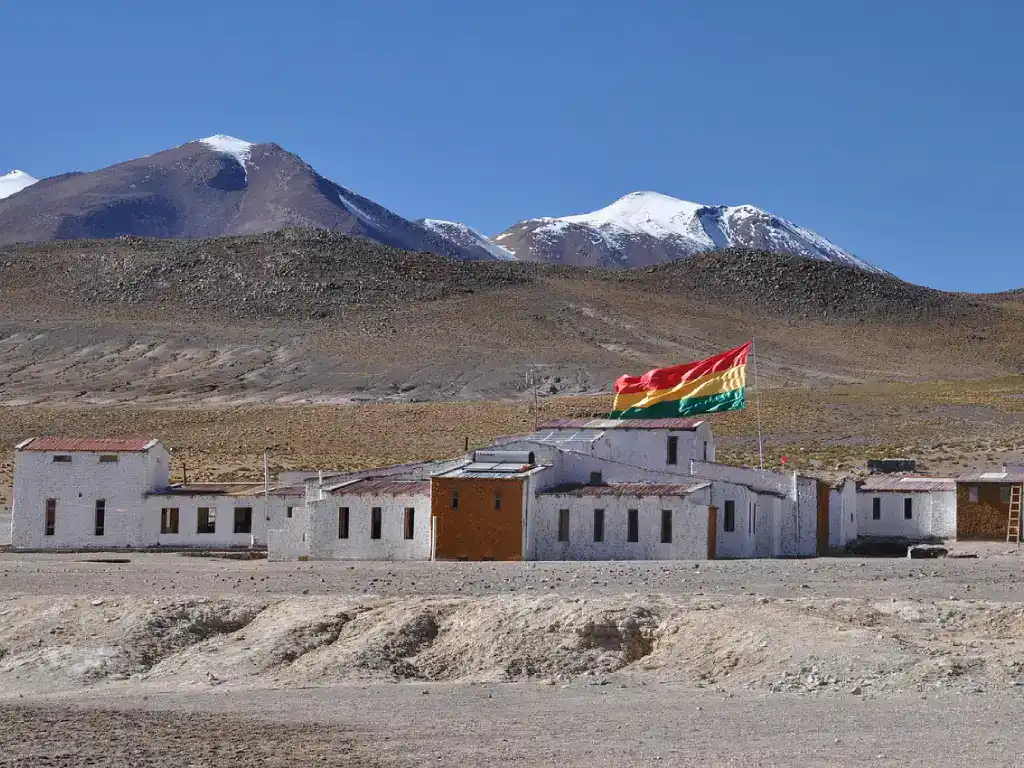
Common Bolivia Flag Questions
The emblem in the centre of the Bolivian flag is the Bolivian coat of arms, and it packs a lot of symbolism. It includes Mount Potosí, which represents Bolivia’s rich mining history, a llama (the national animal), and a bundle of wheat to symbolise agriculture. The crossed rifles & axe show readiness to defend, while the laurel branches represent peace. The entire thing is encircled by the name “Bolivia” and framed with a condor, flag spears & cannon – basically, the full dramatic works.
The word “Wiphala” comes from the Aymara language. It’s a blend of wiphai (a joyful exclamation) & laphaqi (describing wind movement). Together, they form a term that basically means “fluttering shout of triumph” – a poetic way to describe a flag waving in victory.
It’s pronounced “wee-PAH-lah”. The “wi” sounds like the start of “weaving”, & the emphasis is on the middle. You might hear it said slightly differently in different parts of the Andes, but that version will keep you out of trouble most places.
What do the colours mean?
Each colour in the Wiphala has its own meaning – not random, not just rainbow vibes. Here’s the general breakdown:
- Red: The Earth, life force & Indigenous heroes
- Orange: Society & culture
- Yellow: Energy, strength & the resources of the land
- White: Time, harmony & spirituality
- Green: Nature, fertility & growth
- Blue: The cosmos & water
- Purple: Indigenous government & self-determination
When arranged diagonally in that grid, it’s meant to show balance between the elements, the people & the cosmos.
In this view, red & orange ground the flag in human culture & the land, while blue, white & violet symbolise time, energy & the universe – echoing Andean ideas like Pachamama (Mother Earth) & Pachakama (cosmic order). It’s a mix of the earthly & the otherworldly – a rainbow roadmap between people & the stars.
Want to dig into what each colour on the Wiphala actually stands for? I broke it down in a quick guide on the Wiphala flag colours & their meaning – covering the symbolism behind that rainbow grid & why it’s more than just good vibes.
You can see some of these themes echoed in how the country views its land & natural resources. If you’re heading there, it’s also worth knowing what Bolivia’s climate is like by region & when’s the best time of year to visit Bolivia if you want to catch Wiphala-flying festivities.
Wiphala flag configuration
Wiphala purists are particular – for good reason. The flag is always a perfect square, made up of 49 squares in a 7×7 grid. The colours run diagonally from red in the bottom-left to violet in the top-right. This layout isn’t just pretty – it reflects harmony across nature, time & society. Anything that’s rectangular or misaligned isn’t considered a proper Wiphala… it’s just tourist tat.
History of the Wiphala Flag
The Wiphala traces back to pre-Columbian civilisations, particularly the Tiwanaku culture. While not much remains from those times visually, similar geometric motifs have turned up in ceramics & textiles. The modern version started gaining popularity in the 1970s during Indigenous rights movements & eventually became a political & cultural icon.
And if you’re wondering how Bolivia got its name in the first place, you’ll love this quick read on who Bolivia is named after – it’s not as obvious as you’d think.
Original Wiphala flag
The original Wiphala didn’t look exactly like the rainbow design you see today – but the grid-based layout? That’s been around for ages. Ancient Andean civilisations like Tiwanaku used similar patterns in textiles & pottery. The modern form is more of a revival than a replica – a reimagining of Indigenous symbols for the current day.
Is it just used in Bolivia?
Not quite. The Wiphala also shows up in parts of Peru, Ecuador & northern Chile, but only Bolivia has given it official national flag status. That said, it’s a pan-Andean symbol – so it’s common to see it flown by activists, Indigenous groups & cultural festivals across the region.
If you’re planning a trip & wondering what it’s like day-to-day, check out what it’s actually like to live in Bolivia or how safe Bolivia is for tourists. It’ll give you a real feel for how visible symbols like the Wiphala are outside the big cities, and also how this affects the Bolivian crime rate too. And if you’re looking for more of a complete guide to Bolivia, I have you covered there too!
The Patujú Flag — Wiphala’s Lowland Counterpart
The Patujú isn’t as famous, but it’s just as meaningful – especially in Bolivia’s eastern lowlands.
It features a white field & the pink Patujú flower – a symbol of regional pride, Amazonian roots & a counterweight to highland narratives.
It rose to prominence during protests in 2009 & still appears at demonstrations today.
What is the Quechua Flag?
The Quechua flag, often represented by the Wiphala, is a symbol of Indigenous identity. There’s no single, official Quechua flag that’s recognised across South America – but many people use the Wiphala to symbolise Quechua identity. It’s a rainbow-coloured, checkered design that’s become a powerful emblem of Indigenous pride, especially across the Andes.
While the Wiphala technically represents all Andean peoples, including both Quechua & Aymara groups, its colourful presence is often closely linked with Quechua language, culture & history. So if you’ve seen the Wiphala referred to as the Quechua flag… you’re not the only one.
Does the Aymara Flag Exist?
Short answer: not really – but kind of. There’s no separate Aymara flag in the way you might expect. Instead, the Wiphala is widely embraced as a shared symbol of Aymara identity, particularly in Bolivia where it’s even recognised as a national flag alongside the tricolour. Different versions of the Wiphala technically represent different Andean regions – with the one tied to La Paz (an Aymara stronghold) often being the most used. So while there’s no single flag that only represents the Aymara people, the Wiphala plays a big role in Aymara pride, protest & cultural expression.

Final Thoughts
The Wiphala isn’t just a splash of colour – it’s a visual shout of identity, history & unity. For many Bolivians, especially in the west, it means just as much (if not more) than the standard flag. Whether you see it in a protest, hanging in a market stall or stitched onto a backpack, now you’ll know what it’s saying. These symbols also say a lot about Bolivia’s pride – and help to challenge the whole “poor country” label outsiders love to throw around.
Some even say the Wiphala’s diagonal layout reflects natural cycles – with the upper part symbolising the sun & daytime, while the lower squares nod to the moon & night. Cosmic balance with a checkerboard twist.
Fun fact: The Wiphala is always square. If you ever see a rectangular version, it’s a tourist knockoff or someone’s misprint. Purists take it very seriously.
Seen the Wiphala in the wild? Spot any cool uses of it on your travels? Drop a comment – I’d genuinely love to hear/ see it.
Happy Travels!

